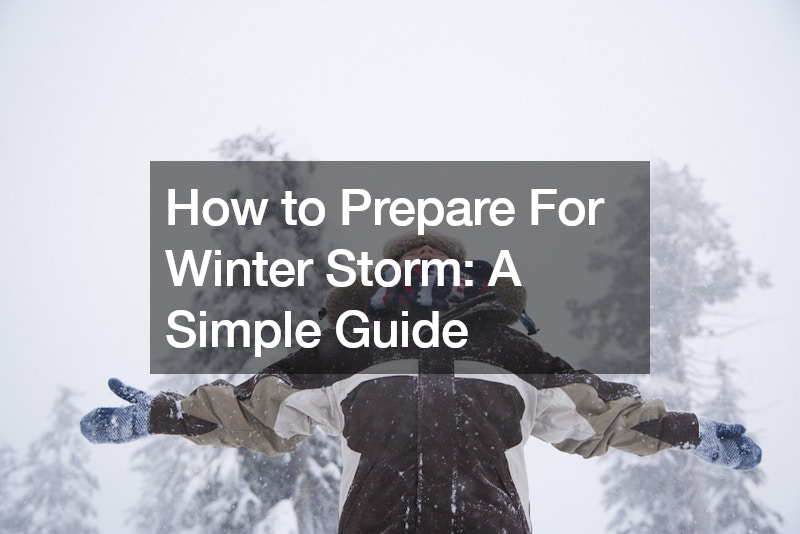
p>Winter storms can bring heavy snowfall, freezing temperatures, and dangerous conditions. Being prepared for these events is crucial to ensure the safety and well-being of yourself and your family. In this simple guide, we’ll outline practical steps you can take to prepare for a winter storm and minimize its impact on your home and daily life.
1. Stay Informed
Keep an eye on weather forecasts and warnings issued by reliable sources like The Weather Channel or local meteorological agencies. Stay informed about the severity and timing of the storm so you can make necessary preparations ahead of time.
Listen to local news updates on radio or television for any changes in weather conditions and advisories from authorities.
2. Prepare Your Home
Inspect your home for any potential vulnerabilities to winter weather. Make sure your roof is in good condition and consider installing gutter snow guards to prevent ice dams from forming. Insulate pipes to prevent freezing and consider investing in a backup generator in case of power outages. Seal any drafts around windows and doors to keep cold air out and warmth in.
3. Stock Up on Supplies
Ensure you have an ample supply of essential items such as food, water, medications, and batteries. Stock up on non-perishable food items that can sustain you and your family for at least a week. Include items like canned goods, dry goods, and shelf-stable snacks. Don’t forget to include items for your pets as well, such as pet food and extra bedding.
4. Create an Emergency Kit
Assemble an emergency kit containing essential items such as flashlights, blankets, a first aid kit, and a battery-powered radio. Include any necessary medications, important documents, and a list of emergency contacts. Consider adding items like hand warmers, extra clothing, and a portable phone charger to your kit.
5. Prepare Your Vehicles
Check your vehicles to ensure they are in good working condition for winter driving. Equip them with snow tires, windshield wipers, and emergency supplies such as a shovel, ice scraper, and sand or kitty litter for traction. Keep your gas tank at least half full to prevent fuel lines from freezing. Pack a roadside emergency kit in your car with items like jumper cables, a flashlight, and non-perishable snacks.
6. Plan for Power Outages
If you rely on electric heating, consider alternative sources of heat such as a fireplace, wood stove, or portable space heater. Keep extra blankets and warm clothing on hand to stay comfortable during power outages. Have a backup power source such as a generator or solar-powered charger for essential devices like cell phones and medical equipment.
7. Stay Indoors and Stay Safe
During the storm, it’s safest to stay indoors and avoid unnecessary travel. Keep children and pets indoors and dress warmly if you need to go outside. Be cautious of slippery surfaces and avoid overexertion when shoveling snow. Monitor local news and weather updates for any changes in conditions or emergency alerts.
8. Check on Neighbors
Check on elderly or vulnerable neighbors to ensure they are safe and have everything they need. Offer assistance with snow removal or transportation if necessary. It’s important to look out for one another during times of inclement weather. Consider organizing a neighborhood watch or communication system to keep everyone informed and connected during storms.
9. Stay Calm and Be Patient
Winter storms can be stressful and disruptive, but it’s essential to remain calm and patient. Focus on taking care of yourself and your loved ones, and remember that the storm will eventually pass. Use this time to bond with family members and enjoy indoor activities together. Practice relaxation techniques such as deep breathing or meditation to reduce stress and anxiety.
10. After the Storm
Once the storm has passed, assess any damage to your property and make necessary repairs. Clear snow and ice from sidewalks, driveways, and gutters to prevent accidents and water damage. Take the time to restock your emergency supplies and prepare for future storms. Reflect on your experiences during the storm and identify any areas for improvement in your preparedness plan. Share your insights and lessons learned with friends, family, and neighbors to help them better prepare for winter storms in the future.
By diligently following these straightforward steps, you equip yourself and your loved ones with the necessary tools to weather winter storms effectively, safeguarding your safety and well-being. It’s paramount to remain vigilant, staying abreast of weather updates and heeding any warnings or advisories issued by authorities. Prioritize staying indoors and minimizing outdoor exposure during inclement weather conditions to mitigate risks and ensure your protection.
With thorough preparation and prudent precautions, you can confidently navigate any winter storm that comes your way. From stocking up on essential supplies to fortifying your home against harsh weather elements, each proactive measure enhances your resilience and readiness to face challenging circumstances. By adhering to these guidelines, you establish a solid foundation for weathering storms with confidence and security.
.



